East Anglian Archaeology is an academically refereed series providing an outlet for reports from the East of England – Norfolk, Suffolk, Essex, Cambridgeshire, Hertfordshire, Bedfordshire. The first East Anglian Archaeology report was published in 1975 and new titles are still appearing every year.
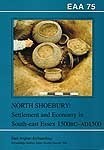
Format: Paperback
Pages: 196
ISBN: 9781852811303
Pub Date: 31 Dec 1995
Series: East Anglian Archaeology Monograph
Illustrations: 25 pl 122figs, fiche
Description:
The North Shoebury Project was mounted in response to the accumulating evidence for settlement in the Southend Peninsula during virtually all periods from the prehistoric to the present day, especially widespread and possibly continuous from the Neolithic. The site itself lay on a brickearth covered gravel terrace, whose calcareous nature resulted in the preservation of bone and shell. This excavation report includes discussion of the evidence for occupation in each period, and a gazetteer of antiquities of the region.
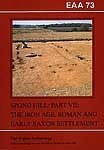
Format: Paperback
Pages: 168
ISBN: 9780905594163
Pub Date: 31 Dec 1995
Series: East Anglian Archaeology Monograph
Illustrations: with illus, 4 fiche and site-plan
Description:
Sparse Iron Age occupation was followed by extensive rural occupation, building up over three phases in the Roman period to a large 2nd-4th AD farmstead. In the late 4th century AD this was abandoned for no archaeologically discernible reason to lay the ground for the famous Anglo-Saxon cemetery. Ecofactual evidence for crop-processing (including flax) and artefactual evidence for many craft activities are presented.
The large collection of Roman pottery is the first from an excavation in Central Norfolk to receive detailed analysis and indicates fineware flows mostly from the Nene valley. This report fills the gap between Spong Hill 6 (prehistoric occupation) and the cemetery reports, most of which are still available.
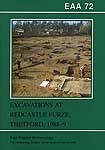
Format: Paperback
Pages: 147
ISBN: 9780905594156
Pub Date: 31 Dec 1995
Series: East Anglian Archaeology Monograph
Illustrations: with 102 figs, 9 plates & microfiche.
Description:
Aby Phil Andrews and othersWhilst the earliest evidence for major occupation in Thetford, Norfolk, comes from the Iron Age, it was during the 10th and 11th centuries that the town developed into a major town so that by Domesday , population estimates place it amongst the six most important towns in England. In 1987 a sizeable area became availalble for excvation ahead of housing development, providing an opportunity to look for further evidence of occupation in the Early and Middle Saxon periods, as well as to investigate a part of the town which was still occupied during the late 11th and 12th centuries whan the Late Saxon settlement was in decline. This report contains details of the excavations, finds, and zoological and botanical evidence.
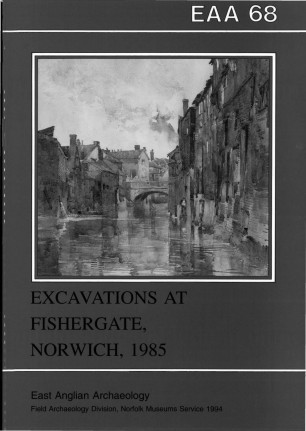
Format: Paperback
Pages: 94
ISBN: 9780905594132
Pub Date: 31 Dec 1994
Series: East Anglian Archaeology Monograph
Illustrations: with 37 figs, 7 plates, 32 tables & microfiche.
Description:
^Aby Brian S. Ayers ^DReport on excavations undertaken off Norwich's Fishergate to the north of the River Wensum, the first to reach Saxon deposits in this important southern end of the city. The site produced the largest single assemblage of Ipswich-type ware from Norwich, imported pottery of Middle Saxon and Saxo-Norman date, a range of 8th-century finds, as well as quantities of later Saxon and Saxo-Norman material.
The report examines the excavation sequence; the artefacts; the environmental evidence, detailing knowledge of the river and its environs; the documentary evidence, drawing on material from the Enrolled Deeds and other sources, outlining the development of the area; post-medieval industrial buildings on the site.
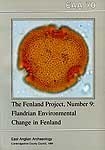
Format: Paperback
Pages: 353
ISBN: 9780951954416
Pub Date: 31 Dec 1994
Series: East Anglian Archaeology Monograph
Illustrations: with text-figs & illus.
Description:
^Aby Martyn Waller ^DVolume Number 9 from the Fenland Project details the results from the palaeoenvironmental programme completed between 1983 and 1989. It contains the database and reconstructions of past environmental conditions derived from the study of the recent (Flandrian) deposits of Fenland, and helps place the archaeological sites discovered by the field survey within their contemporary landscape. The first part of the book discusses previous studies and methodology, interpretative models and data synthesis, pollen analysis and radiocarbon dating, whilst the second contains details of the stratigraphic information collected from over 40 sites in the Fenland.
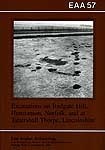
Format: Paperback
Pages: 128
ISBN: 9780905594101
Pub Date: 31 Dec 1993
Series: East Anglian Archaeology Monograph
Illustrations: with 25 plates, 64 figs, 65 tables and microfiche.
Description:
^Aby R. Bradley, P. Chowne.
R. Cleal, F. Healy and I. Kinnes ^DCurrent research in the prehistory of the East Anglian Fens, centred on the Fenland Project, attaches new significance to complementary work on the upland surrounding the basin. This volume brings together the very different results of two area excavations, at Tattershall Thorpe in Lincolnshire on the north-western edge of the Fens, and at Hunstanton in Norfolk, on the north-eastern edge. Both sites are the cumulative result of intermittent activity spread over hundreds of years, and both provide examples of apparently structured Later Neolithic pit deposits. Hunstanton fills out an already extensive picture of clearance, enclosure and land division in prehistory; and the largest structure uncovered there, a so far unparalleled trapezoid enclosure, is a reminder that whole classes of monument may yet remain unrecognised, even in relatively well-explored regions such as East Anglia.
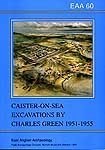
Format: Paperback
Pages: 290
ISBN: 9780905594071
Pub Date: 31 Dec 1993
Series: East Anglian Archaeology Monograph
Illustrations: with 36 plates, 174 figs, 69 tables & microfiche.
Description:
The Roman defended site at Caister, hitherto viewed as a small town, can now be seen as an early coastal fort probably contemporary with Reculver and Brancaster, both of which appear in the Notitia Dignitatum as forts of the Saxon shore. The Caister fort is of earlier Roman type, with a defensive wall backed up by an earthen rampart. Finds indicate occupation by cavalry from the early 3rd century to later 4th century, although specifically late military equipment is absent.
The site was unoccupied until the Middle Saxon period, when outside the walls an extensive cemetery developed which was in use from the 8th to 11th centuries. Several burials containing rows of clench nails indicate that parts of boats were used as coffin lids or biers. Further burials were recorded within the fort itself, and both cemeteries exhibit Christian characteristics. It is likely that they were associated with a church, perhaps a minster. Was Caister, rather than Burgh Castle, Fursa's monastery of Cnobheresburg?
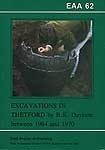
Format: Paperback
Pages: 235
ISBN: 9780905594088
Pub Date: 31 Dec 1993
Series: East Anglian Archaeology Monograph
Illustrations: with 36 plates, 176 figs & microfiche.
Description:
^Aby Carolyn Dallas ^DReport on the excavations of Anglo-Saxon and Medieval Thetford carried out between 1964 and 1970, including Brandon Road (1964-66) and the Kilnyard (1966), with reports on the finds, zoological and botanical evidence, documentary evidence, and a general discussion. Important discoveries included six related Late Saxon pottery kilns and the complete plan of a pre-Conquest timber church which was replaced in stone.
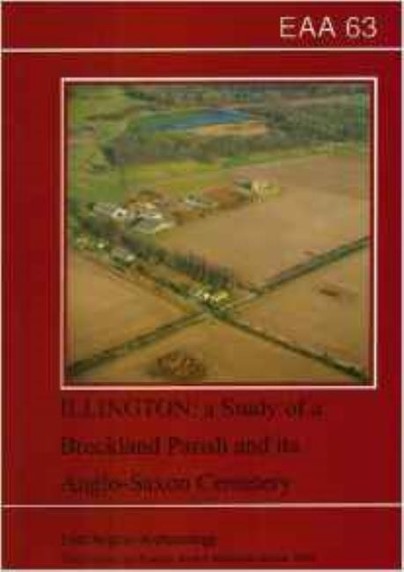
Format: Paperback
Pages: 114
ISBN: 9780905594095
Pub Date: 31 Dec 1993
Series: East Anglian Archaeology Monograph
Illustrations: with 15 plates, 59 figs, 15 tables and microfiche.
Description:
^Aby A. Davison, B. Green and W.
Milligan ^DPart of the Anglo-Saxon cemetery at Illington was excavated by Group Captain Knocker in 1949. 200 cremation urns and 3 inhumations were mapped and lifted, and the remains of about two hundred other vessels were also recovered. Many of the decorated urns belong to the Illington/Lackford workshop, and the finds assemblage as a whole suggests that the cemetery was in use during the 6th and 7th centuries. The cremated human bones were the subject of a pioneering study by the late Calvin Wells. Alan Davison's parish survey did not locate any Early Saxon domestic sites, and it is thought that the original Saxon holding may have been larger than the medieval parish.
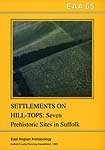
Format: Paperback
Pages: 67
ISBN: 9780860552147
Pub Date: 31 Dec 1993
Series: East Anglian Archaeology Monograph
Illustrations: with 8 plates, 43 figs and 3 tables.
Description:
Report on excavations and discussion of artefacts and zoological evidence from seven prehistoric sites in Suffolk: an Iron Age enclosure at Barnham; two first millennium BC settlements at Barnham; three prehistoric hill-top settlements in south-east Suffolk; an Early Iron Age hill-top site at Framlingham.
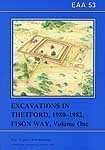
Format: Paperback
Pages: 213
ISBN: 9780905594057
Pub Date: 31 Dec 1992
Series: East Anglian Archaeology Monograph
Illustrations: text, 156 figs, 42 tables, 2 microfiche.
Description:
The discovery of the Thetford treasure (a spectacular hoard of late Roman gold and silver jewellery), a mass of late Roman finds from metal detecting and a striking multiple enclosure cropmark led to the decision to excavate 5ha of this site in advance of development. The principal use of the site belongs to the Iron Age and Early Roman period, ending in the mid 60s AD. A series of hilltop enclosures dating back to the Middle Iron Age is replaced, at about the time of the Roman conquest, by a single substantial circular building within a double-ditched enclosure, surrounded by smaller peripheral enclosures containing possible graves.
A rapid period of expansion follows as the main enclosure is massively enlarged, further circular buildings appear and the space between the inner and outer ditches is packed with rows of upright timbers. Most, if not all, of the extra-mural features are swept away. By the mid 60s AD the site had been dismantled perhaps demolished in the aftermath of the Boudiccan revolt. The major investment of resources over a relatively short time indicates the importance of this grand and unusual site. Evidence for agricultural production and domestic occupation is scarce, compared to metal-working debris, including coin moulds. The author argues that this exceptional site in its final form a two-storied Romano-Celtic temple within an extensive 'artificial oak grove' was a uniquely important religious, tribal and ceremonial centre for the Iceni.
EAA 52: The Fenland Project No.4
Format: Paperback
ISBN: 9780905594040
Pub Date: 31 Dec 1991
Series: East Anglian Archaeology Monograph
Illustrations: p, 75figs, 12pls, microfiche.
Description:
The second Norfolk volume covers a substantial tract of peat fen defined by three rivers, and incorporates the only island of any size in the Norfolk Fens. The rapid shrinkage of peat on the upland edge has revealed a densely-occupied zone that was settled from the Mesolithic through to the Bronze Age. Human settlement is viewed against changing environmental conditions as the Embayment became waterlogged and the fen edge was deserted in historic times.
Investigation of the Roman road known as the Fen Causeway revealed a canal, and the associated salt-making and peat cutting economy.












